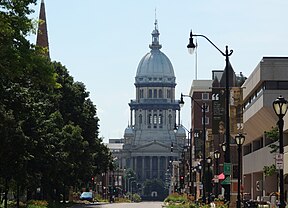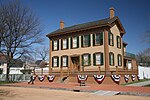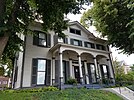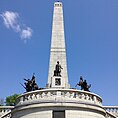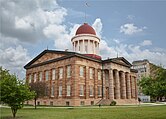Springfield, Illinois | |
|---|---|
Downtown Springfield and the Illinois State Capitol | |
| Motto: Home of President Abraham Lincoln[1] | |
 Interactive map of Springfield | |
| Coordinates: 39°47′51″N 89°38′42″W / 39.79750°N 89.64500°W[3] | |
| Country | United States |
| State | Illinois |
| County | Sangamon |
| Townships | Capital, Springfield, Woodside[2] |
| Founded | April 10, 1821[4] |
| Incorporated Town | April 2, 1832[4] |
| City Charter | February 3, 1840[5] |
| Government | |
| • Type | Mayor-Council |
| • Mayor | Misty Buscher (R) |
| Area | |
• Total | 67.49 sq mi (174.79 km2) |
| • Land | 61.16 sq mi (158.41 km2) |
| • Water | 6.33 sq mi (16.38 km2) |
| Elevation | 600 ft (183 m) |
| Population (2020) | |
• Total | 114,394 |
| • Density | 1,870.37/sq mi (722.16/km2) |
| Time zone | UTC−6 (CST) |
| • Summer (DST) | UTC−5 (CDT) |
| ZIP codes | |
| Area code | 217/447 |
| FIPS code | 17-167-11046 |
| GNIS feature ID | 2395940[3] |
| Website | www |
Springfield is the capital city of the U.S. state of Illinois and the seat of Sangamon County. The city's population was 114,394 at the 2020 census, which makes it the state's seventh-most populous city,[10] the second-most populous outside of the Chicago metropolitan area (after Rockford), and the most populous in Central Illinois. Approximately 208,000 residents live in the Springfield metropolitan area, which consists of all of Sangamon and Menard counties.[11] Springfield lies in a plain near the Sangamon River north of Lake Springfield. The city is on historic Route 66.
Springfield was settled by European-Americans in the late 1810s, around the time Illinois became a state. The most famous historic resident was Abraham Lincoln, who lived in Springfield from 1837 until 1861, upon becoming President of the United States. Major tourist attractions include multiple sites connected with Lincoln including the Abraham Lincoln Presidential Library and Museum, Lincoln Home, Old State Capitol, Lincoln-Herndon Law Offices, and the Lincoln Tomb. Largely on the efforts of Lincoln and other area lawmakers, as well as its central location, Springfield was made the state capital in 1839.
As the state capital, the government of Illinois is based in Springfield. Springfield's economy is dominated by government agencies and adjacent firms that work with state and county governance, in addition to healthcare and medicine. State government institutions include the Illinois General Assembly, the Illinois Supreme Court, the office of the Governor of Illinois and historic Illinois Governor's Mansion. The University of Illinois Springfield has its campus near Lake Springfield. Weather is fairly typical for middle-latitude locations, with four distinct seasons. The city has a mayor–council form of government and governs the Capital Township. Public schools in Springfield are operated by District No. 186.
- ^ Official website
- ^ Cite error: The named reference
portionswas invoked but never defined (see the help page). - ^ a b U.S. Geological Survey Geographic Names Information System: Springfield, Illinois
- ^ a b Springfield Online Archived May 1, 2007, at the Wayback Machine Retrieved on April 13, 2007
- ^ "Name of Local Government: Springfield". Illinois State Archives. Archived from the original on April 9, 2022. Retrieved January 24, 2022.
- ^ "2020 U.S. Gazetteer Files". United States Census Bureau. Archived from the original on March 15, 2022. Retrieved March 15, 2022.
- ^ "Geographic Names Information System". edits.nationalmap.gov. Archived from the original on May 5, 2023. Retrieved May 5, 2023.
- ^ "Look Up a ZIP Code". USPS.com. p. 1. Archived from the original on May 12, 2017. Retrieved May 12, 2017.
- ^ "Look Up a ZIP Code". USPS.com. p. 2. Archived from the original on May 12, 2017. Retrieved May 12, 2017.
- ^ "Springfield (city), Illinois". State & County QuickFacts. U.S. Census Bureau. July 8, 2014. Archived from the original on July 3, 2012. Retrieved September 15, 2014.
- ^ "Estimates of Resident Population Change and Rankings: July 1, 2012 to July 1, 2013". U.S. Census Bureau, Population Division. March 2014. Archived from the original on February 12, 2020. Retrieved September 16, 2014.
